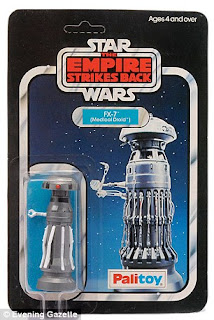SUBJECTS OF CONTEXTUAL RESEARCH ALREADY UNDERTAKEN
Level 4: Semantic Analysis of James Bond Posters
Level 5: Has home video rendered the cinema obsolete?
AIM AND/OR OBJECTIVE OF YOUR PROPOSED C.O.P.3 PROJECT
The relationship of merchandising and illustration (needs a catchier title)
What research needs to be undertaken into the general and specific contexts of your practice?
.Historical context of merchandising - franchising - polymorphous branding
.The use of illustration to improve the marketability of low quality wares - ethics - (First Things First)
.Focus on a specific brand - Disney / Star Wars
.Nostalgic illustration as a cynical tool
.’Product and Range’ - Asset appropriation
.Merchandise in the age of digital reproduction (Skylanders/Disney Infinity/Team Fortress 2 etc)
What approach(es) will you take and what processes, methods, materials and tools are to be involved in research into your practice?
.Employ industry techniques… (Create humorous/subversive merchandise-tie-ins?)
.Later designs are likely to be largely digital
.Digital designs can be applied onto a range of contexts/merchandise
.Avoid overworking digital designs as usual
.Document primary research of merchandising and point-of-sale displays etc
What preparation or investigations do you need to undertake for your creative practice to take place?
.Find relevant books on the subject - talk to staff etc
.Engage in primary research of inshore and online merchandising
.Look closer into production methods
.Investigate the factory conditions for workers producing the merchandise - ETHICS
.Investigate how merchandise has become a primary product and the ‘art’ and after thought… (Forbidden Planet)
What research do you need to undertake regarding who your creativity is for?
.Again, is this about the ethics of an illustrator? As designers, we are exploiting familiar imagery as a way of selling products that people cannot generally afford or need
.Anti consumerism? Comes back to last years initial CoP concept… apathetic product design that inevitably becomes landfill… environmentalism
.Gender/demographic studies… the marketing of identical products to different audiences through packaging
.Collectors… the value of merchandise dramatically increasing as they become ‘antique’
Primary Sources of Information
Description: Point of Sale/Packaging
Location: Toy stores/Online retailers/fast food restaurants… anywhere merchandise it visible
Description: Commercials/Promotional Material
Location: Television/Web banners/Leaflets etc
Secondary Sources of Information
MILLER, Daniel, 2008, ‘The Comfort of Things’, Polity Press, Caimbridge
BOYLE, David, 2004, ‘Authenticity’, Harper Perennial, London
SLADE, GIles, 2006, ‘Made to Break’, Cambridge, Massachusetts, Harvard University Press
BRYMAN, Alan, 2004, ‘The Disneyization of Society’, Sage Publishers, London
JACKSON, Peter, LOWE, Michelle, MILLER, Daniel, MORT, Frank, 2000, ‘Commercial Cultures’, Berg, Oxford
Perceived problems or difficulties:
I have not yet formed a conclusive opinion on the matter… which will develop during research
.The question needs to be specified further





